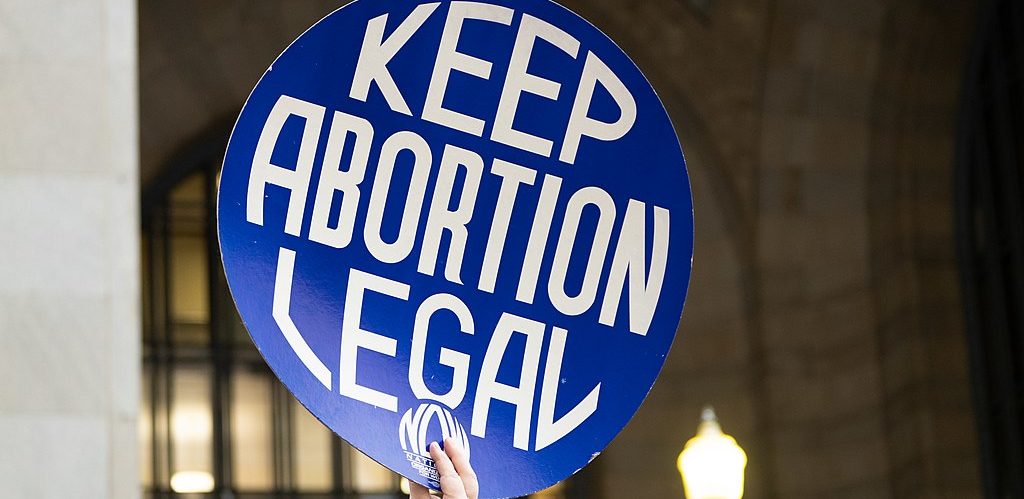 By: Robyn Baker
By: Robyn Baker
How do we express the feeling experienced on May 3rd, when a leak of the majority opinion drafted by Justice Samuel Alito stated that the U.S. Supreme Court “hold[s] that Roe and Casey must be overruled"? A shockwave of dread, anger, confusion, fear, and frustration rippled across the country. This draft came as the worst of reminders that women’s rights can never be taken for granted.
Just a few days away from Mother’s Day, this leak provided a critical moment for national reflection, advocacy for consent-based motherhood, and democracy. Women’s rights are under constant threat across the world, often stagnating when their contribution to gender equality becomes more tangible.
The universally-unequal distribution of caregiving and the gender pay gap are examples among many. How can a country’s judicial branch expect, given those disproportionate circumstances, women to pursue educational goals, participate in the workforce, and gain financial independence alongside fellow citizens who will be unaffected by this repeal?
The heart of the leaked decision is that, because abortion is not mentioned in the Constitution, there is a lack of substantive constitutional support for the precedent established by Roe vs. Wade and reinforced by Planned Parenthood of Southeastern Pa. vs. Casey. However, this interpretation renders judicial precedent ineffective. It ignores that judicial cases have taken into account the modern context of constitutional rights and that constitutional amendments over the last centuries have not been the only mechanism for expanding human rights protections.
In what terms can we cultivate a common, Partnership-based dialogue? How can we promote positive change of the political system that is allowing the standard of women’s bodily autonomy to backslide? Let’s talk numbers.

Abortion Rights are Economic Rights
According to research and advocacy organization Child Care Aware, the national average among all states is between $9,200 and $9,600 USD a year for one child. This staggering figure is borne only by the households who have access to childcare facilities, which prove to be far and few in-between.
In 2018, the Center for American Progress found that 51% of registered American households are situated in “childcare deserts,” or areas with an insufficient supply of licensed, high-quality child care. This challenge is faced by the households who have desired to create and raise a child, and its far-reaching impact on the financial capacity of the household to provide for its child(ren) can be further described by innumerable measures of emotional strain and economic stress. What about the diversity of households, from individuals to families, who do not desire or have the capacity to bring a child into our world?
Childcare costs only touch upon the surface of the investment of time and resources into caring for a single child from birth to early adulthood. Women do not receive any form of universal financial support for maternal care during pregnancy, maternal mental health services, nor the cost of childbirth in a medical facility. Certain health insurance plans can provide partial-to-complete coverage of childbirth in a registered hospital, including Medicaid, but such coverage does not guarantee an affordable childbirth.
The Economic Catastrophe of Overturning Roe v. Wade
According to a 2013 report by Truven Health Analytics, average Medicaid payments were $9,131 and $13,590 for vaginal and cesarean births respectively. These payments cover only a fraction of the average charges to Medicaid were $29,800 for vaginal births and $50,373 for cesarean births. Recall that Medicaid provides means-tested financial assistance to mothers, and all mothers must therefore earn below a given income threshold, have private insurance, have employer insurance coverage that includes maternal-newborn care, or pay out of pocket in order to have a hospital birth. The Truven Report found that out-of-pocket costs for a vaginal birth averaged $2,244 for mothers covered by commercial insurance, but this cost varies dramatically with complications that arise in labor or the need for a cesarean.
Combined with the slow struggle for economic recovery from the Covid-19 pandemic and rising inflation, these cost estimates should be reevaluated for a better understanding of the true cost of childbirth at the time of a potential repeal of Roe vs. Wade.
A Devaluation of Women's Lives
Furthermore, women do not only face a higher financial burden upon deciding to carry a pregnancy to term but also significantly higher chances of pregnancy-related health complications and death. The U.S. continues its infamous ranking as having the highest maternal mortality rate among developed countries, with 720 maternity-related deaths recorded in 2017 as a stark contrast to the 2 recorded maternity-related deaths in Denmark and Finland respectively.
According to this indicator, a maternal death refers to the death of a woman while pregnant or within 42 days of termination of pregnancy, irrespective of the duration and site of the pregnancy, from any cause related to or aggravated by the pregnancy or its management. Using data from the U.S. Center for Disease Control and Prevention Pregnancy-Related Mortality Surveillance data, researchers Roosa Tikkanen et al. found that the highest likelihood of maternal death occurs during the nine months of pregnancy. We cannot understate this figure, which shows that women would be forced to risk their lives in a post-Roe United States in significantly disproportionate ways given their lack of willingness to become mothers.
Considering the pre-existing lack of maternal health coverage and glaring racial disparities in maternal mortality, a repeal of Roe vs. Wade is a direct attack upon the rights and liberties of all women in the U.S. with major implications for racial equality.
The World Health Organization identifies “unsafe abortion [as] a leading, but preventable, cause of maternal deaths[, leading] to physical and mental health complications and social and financial burdens for women, communities and health systems.” As a result, the WHO emphasizes that “lack of access to safe, timely, affordable and respectful abortion care is a critical public health and human rights issue.”
The Center for Partnership Systems emphasizes the importance of using such rhetoric when advocating for safe, legal abortions, as they are truly a human rights issue for an entire society. Every policy affecting the status of women and public perception of their bodily autonomy is a direct reflection of the human rights standards of the corresponding country.
The Constitutionality of Abortion
If the argumentation is considered too political to be considered a valid economic or human rights standard to provide legal, safe, and timely abortions according to Roe vs. Wade, we can finally turn to the same strategy of constitutional reasoning as the current Supreme Court itself. Given that judicial precedent is no longer applicable in the leaked majority opinion, the CPS turns to the U.S. Bill of Rights to present the legal reasoning for the continuation of Roe vs. Wade. The majority opinion relies solely upon the Tenth Amendment of the Bill of Rights, that “powers not delegated to the United States [federal government] by the Constitution, nor prohibited by it to the States, are reserved to the States respectively, or to the people.” However, this judicial interpretation of Roe vs. Wade and Planned Parenthood vs. Casey has a fatal flaw in overlooking the weight of the Eighth and Ninth Amendments, which can be used as a constitutional counterargument.
Ninth Amendment of the Bill of Rights
The Ninth Amendment clearly states “the enumeration in the Constitution, of certain rights, shall not be construed to deny or disparage others retained by the people.” Moreover, the Constitution cannot be used to justify the withdrawal of rights previously exercised by the citizenry. Given the right to safe abortion has been exercised by women across all U.S. states since 1973, the passage of this majority opinion is a direct contradiction of the Ninth Amendment.
Eighth Amendment of the Bill of Rights
Furthermore, the opinion is unconstitutional on the basis of the Eighth Amendment, which protects citizens against “cruel and unusual punishments inflicted.” Given the statistically significant health and mortality risks that arise during pregnancy, childbirth, and the postpartum period, carrying an unintended pregnancy to term is in evident alignment with “cruel and unusual punishments inflicted” upon the female population. The dramatic increase of unsafe attempts at abortions that would indisputably follow the repeal of Roe vs. Wade adds even greater weight to the cruelty and preventability of such mental and physical suffering if reproductive health clinics were able to continue providing abortions in every state. In families and communities adverse to abortion, we cannot overlook the stigma that would threaten the well-being of women and girls who discover they have become pregnant unintentionally or related to assault.
The fact that most trigger laws prepared to take effect to reduce legal abortions to assault-related cases require reporting and proving such assault to a third party (i.e. local police force) adds insult to injury, as it denies women their personal agency to make the decision that most resonates with their recovery. Forcing women who have experienced assault to pursue this narrow route to safe abortion is certainly unusual in contrast to present-day accessibility and does not conform to any other definition of cruel.
Beyond the physical and emotional hardships of pregnancy, intended or otherwise, the aforementioned financial consequences of childbirth and caretaking also render a repeal Roe vs. Wade as unconstitutional under the latter part of the Eighth Amendment. In its entirety, the Eighth Amendment continues to state that “excessive bail shall not be required, nor excessive fines imposed” upon citizens. Surrendering the nationwide right to safe abortion entails subjecting a household to the cost of pregnancy healthcare and childbirth with, in and of itself, is excessive when contrasted to the economic reality of the household with available abortion. Including the additional cost of maintaining living standards, childcare, and the loss of economic opportunity to pursue education and/or career goals, the Eighth Amendment should not be forgotten in the judicial argument for the continuation of Roe vs. Wade.
Our Constitutional Counterargument
Viewed from this constitutional perspective, making the informed, personal decision to have an abortion is the most selfless and loving act a woman can do for herself, her family, and society at large. Having the maturity to recognize that one is not emotionally, financially, or physically prepared to accept the risks of pregnancy and the responsibility of child caretaking has a positive ripple effect for the quality of every life involved.
Removing nationwide abortion access has nothing to do with life. If it did, children should be able to learn and thrive in their schools and grow in happy, healthy homes. It has nothing to do with social justice, as this repeal will prevent equal opportunities among demographics across socio-economic lines, causing a backslide in the hard-earned awareness brought about by the Black Lives Matter movement and further solidifying the erroneous correlation between crime rates and People of Color. Without corresponding reform to the very systems that are failing to provide an affordable, high-quality standard of parental support and child development across the country, so-called “trigger laws” risk making abortion illegal in over half of states, to the extent that several states such as Arkansas offer no exceptions. It has everything to do with women’s bodies.
Contrary to the argument presented by the leaked majority opinion, the above factors make the repeal of Roe vs. Wade glaringly unconstitutional. A subversion of the Constitution to justify the repeal presents the U.S. with one of the biggest human rights decisions of its 21st century history. This decision will prove to carry implications for everyone in every generation, both today and those to come, and can be used to either provide better life or justify nationwide suffering.



Leave a Reply